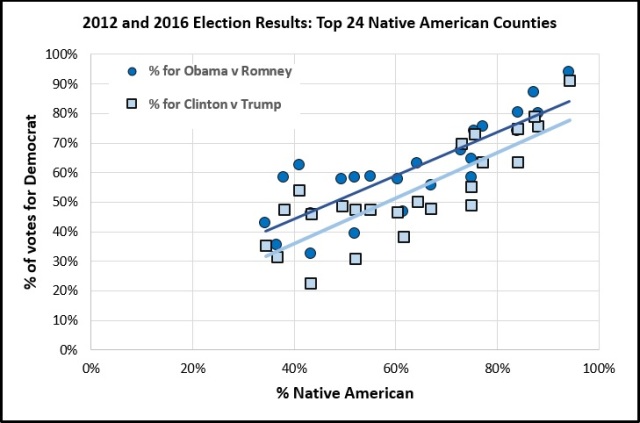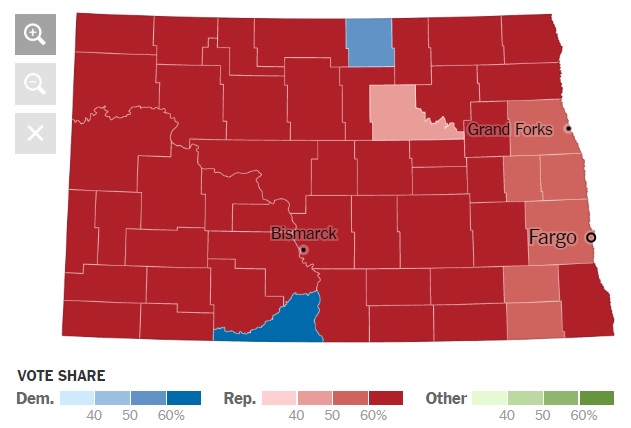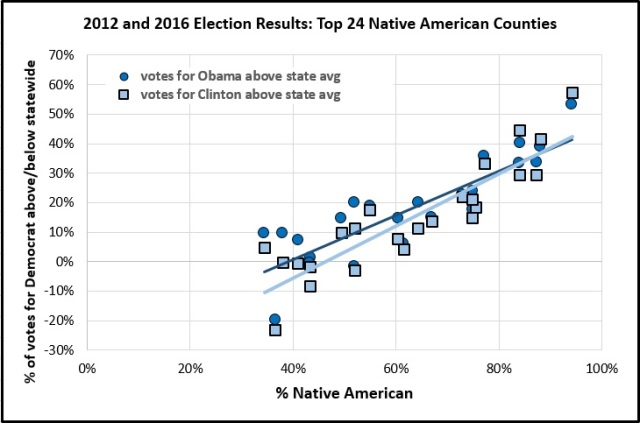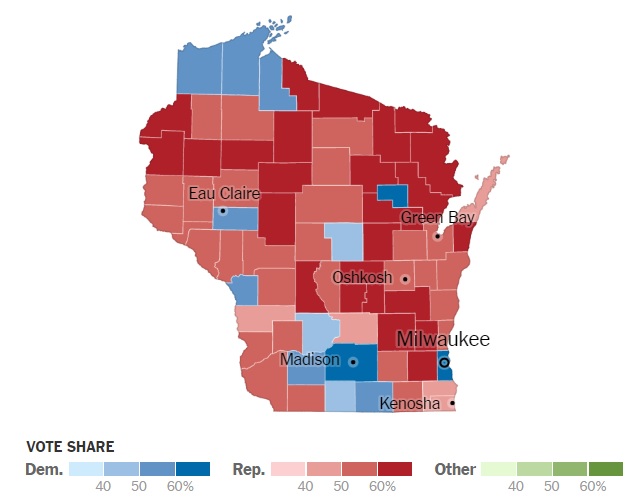 Native Americans voted overwhelmingly against Donald Trump, consistent with their previous support for Barack Obama. In a review of 24 of the most Native American counties in the nation, it is clear that the more Native Americans there are in the county, the greater the percentage of votes there were for Hillary Clinton. The relationship is close to one-to-one, ranging from Cherokee County, OK (34% Native American, 35% for Clinton) to Oglala Lakota County, SD (formerly known as Shannon County) on the Pine Ridge Indian Reservation (94% Native American, 91% for Clinton). Many of these predominantly-Native American counties are in rural areas in red states, surrounded by extremely conservative white ranchers. On county-level maps of election returns, the blue squares are either urban areas or Indian reservations.
Native Americans voted overwhelmingly against Donald Trump, consistent with their previous support for Barack Obama. In a review of 24 of the most Native American counties in the nation, it is clear that the more Native Americans there are in the county, the greater the percentage of votes there were for Hillary Clinton. The relationship is close to one-to-one, ranging from Cherokee County, OK (34% Native American, 35% for Clinton) to Oglala Lakota County, SD (formerly known as Shannon County) on the Pine Ridge Indian Reservation (94% Native American, 91% for Clinton). Many of these predominantly-Native American counties are in rural areas in red states, surrounded by extremely conservative white ranchers. On county-level maps of election returns, the blue squares are either urban areas or Indian reservations.

North Dakota election returns, 2016, by county. Sioux County (84% Native American; 75% for Clinton) is at the bottom. The blue county at the top is Rolette (77% Native American; 63% for Clinton). North Dakota as a whole went 70-30 for Trump.
Comparing to the 2012 Obama/Romney race, support for Clinton was 5 to 10% points lower. When comparing the Native American counties to the statewide average in the states in which they are located, however, the shift away from Clinton is really only significant in the counties with fewer Native Americans, suggesting it was the non-Native Americans (mostly whites) within these counties that shifted from Democrat to Republican to support Trump. The Native Americans did little shifting.

To illustrate this point, let’s look at Sioux County, ND, home of the Standing Rock Indian Reservation and the action against the Dakota Access Pipeline. It is 84% Native American. In 2012, 80% of the votes in Sioux County went to Obama, which was 40% more than the statewide average for North Dakota (which was 60-40 for Romney). In 2016, support for Clinton fell to 75%. However, that was 45% more than the statewide average (which was 70-30 for Trump). Also noteworthy is that Jill Stein of the Green Party polled 11% in Sioux County, one of her highest totals nationwide. Neighboring Morton County, where the pipeline snakes with its military escort, is 94% white, 4% Native American, and voted 73% for Trump.

Wisconsin election returns, 2016. The dark blue county northwest of Green Bay is Menominee County, 87% Native American, 79% for Clinton.
I would be remiss not to add that Native Americans, continually fighting battles for fishing rights, water quality, or just the custody of their children, show a palpable skepticism of both parties. On-line commentary by Native Americans (for example, at the Sacred Stone Camp Facebook group) shows widespread distrust of both political parties. A typical comment reads:
“I know there are people worried about the new president, and I want to let you know that we have suffered under all the American presidents since the establishment of America. Nothing changes for us. We will still be expendable in their eyes. We must continue to stand up and say we have a right to live.” – Ladonna Bravebull Allard

